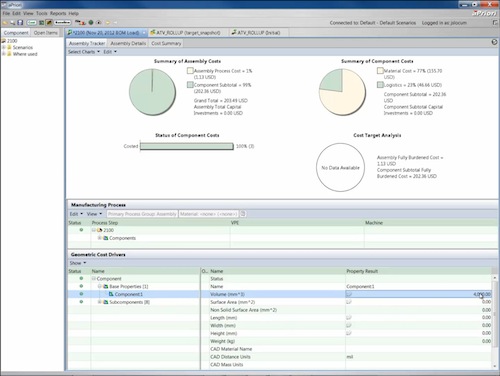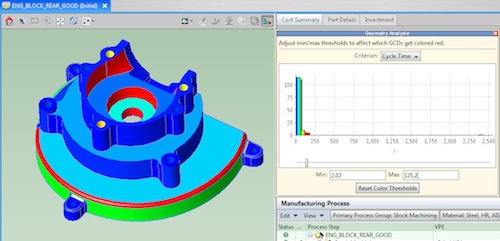aPriori Kicks Costing Up A Notch
Latest News
December 10, 2012
As part of its vision to drive product cost awareness upstream into the earliest stages of product development, aPriori is stepping up its interpretation of the discipline with a new version of the software, which considers costing not just on a component or small assembly level, but takes an aggregate view of costing across the entire product.
The company’s latest release, aPriori 2012r2, is stocked with an array of new capabilities to help engineers as well as sourcing and manufacturing professionals evaluate costs associated with building a product, be it industrial equipment, cars or something as complex and grand scale as an airliner. While challenges vary across industries, global competition, on-going regulatory requirements, and a still lumbering economy is driving a near universal need for keeping product costs down in an effort to boost profitability.
“With more and more competition, there’s a focus on trying to figure out what features drive the most value for customers,” explains Julie Driscoll, aPriori’s vice president, strategic marketing and product management. “Being able to quantify those features, make tradeoffs, and look at the product at higher levels to make strategic decisions is what is driving this need.”
To do so, aPriori is taking costing to a new level in this release, allowing users to import complex engineering bills of materials (BOMs) from ERP, PLM, or other enterprise applications and utilize that data against the aPriori cost engine to calculate costs for new components and subassembly designs while comparing those costs to initial targets. So while the original product allowed a design engineer in an automotive firm to evaluate costs around their specific responsibility—the design of shock absorbers, for example—the newer release builds on that component-level functionality. For example, it may provide additional views for engineering managers to consider costs around the greater chassis assembly, or at an even higher level, for a vice president of engineering to drill down into costs associated with the entire vehicle program.
Having the ability to view costs at an aggregate level is critical for providing visibility into what products are going to cost and what type of margins companies can hope to achieve, according to Rick Burke, aPriori’s vice president of marketing. Viewing products costs at a more holistic level also expands aPriori’s use from a departmental tool to an enterprise-class solution, he says.
“Having individual component cost information is important to guide specific decisions relative to those components,” he explains. “Understanding where that sits at an aggregate level can help determine what a product costs and if it is over cost targets, what areas to focus on for cost reduction.”
In addition to the BOM loader and other product cost roll up features, aPriori 2012r2 has a number of other notable enhancements, including a new geometry analysis tool that — through a color-coded heat map — provides an easy to understand visual roadmap as to where to most effectively focus on reducing costs. There are also enhancements to aPriori’s Virtual Product Environments (VPEs), a digital representation of a real-world factory floor, for improved exploration of cost scenarios as well as streamlined system maintenance, an enhanced Progressive Die model for tooling estimates, and additional cost calculation functions for precision machining, including increased sensitivity to geometric tolerances.
Watch a video demonstration of the BOM loader capability:
Subscribe to our FREE magazine, FREE email newsletters or both!
Latest News
About the Author
Beth Stackpole is a contributing editor to Digital Engineering. Send e-mail about this article to [email protected].
Follow DE







